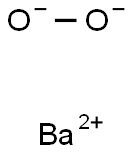Barium peroxide , 95% , 1304-29-6
CAS NO.:1304-29-6
Empirical Formula: BaO2
Molecular Weight: 169.33
MDL number: MFCD00003454
EINECS: 215-128-4
PRODUCT Properties
| Melting point: | 450 °C |
| Boiling point: | losesO2 at 800°C |
| Density | 4,96 g/cm3 |
| Flash point: | 21 °C |
| solubility | reacts with dilute acid solutions |
| form | Powder |
| Specific Gravity | 4.96 |
| color | White |
| PH | 12 (20°C, 10g/L in H2O, slurry) |
| Odor | Odorless |
| Water Solubility | Insoluble in water |
| Sensitive | Moisture Sensitive |
| Merck | 14,989 |
| Stability: | Stable. Strong oxidizer - contact with combustible material may cause fire. Incompatible with organic materials, combustible materials, reducing agents, most common metals. |
| LogP | -0.425 (est) |
| CAS DataBase Reference | 1304-29-6(CAS DataBase Reference) |
| EPA Substance Registry System | Barium peroxide (Ba(O2)) (1304-29-6) |
Description and Uses
Barium peroxide, is a grayish-white powder that is slightly soluble in water. Barium peroxide is a dangerous fire and explosion risk in contact with organic materials and decomposes around 1450°F (787°C). It is also toxic by ingestion, is a skin irritant, and should be kept cool and dry in storage. The four-digit UN identification number is 1449. The primary uses of barium peroxide are in bleaching, in thermal welding of aluminum, as an oxidizing agent, and in the dyeing of textiles.
Bariumperoxide is used as a hydrogen peroxide source and oxygen oxidant, as well as a bleaching agent. Its main usage has been for making hydrogen peroxide and oxygen, in organic syntheses, fabric printing and dyeing. Barium peroxide is available commercially, primarily as the oxctahydrate (which is the more stable form of this peroxide).
Safety
| Symbol(GHS) |    GHS03,GHS05,GHS07 |
| Signal word | Danger |
| Hazard statements | H272-H302+H332-H314-H412 |
| Precautionary statements | P210-P260-P273-P280-P303+P361+P353-P305+P351+P338 |
| Hazard Codes | O,Xn |
| Risk Statements | 8-20/22 |
| Safety Statements | 13-27 |
| RIDADR | UN 1449 5.1/PG 2 |
| WGK Germany | 1 |
| RTECS | CR0175000 |
| F | 3-9-23 |
| TSCA | Yes |
| HazardClass | 5.1 |
| PackingGroup | II |
| HS Code | 28164000 |
| Hazardous Substances Data | 1304-29-6(Hazardous Substances Data) |
| Toxicity | LD50 scu-mus: 50 mg/kg ZVKOA6 19,186,74 |


